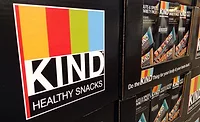FDA Proposes Updated Definition of ‘Healthy’ Claim on Food Packages

Image courtesy of FDA
The U.S. Food and Drug Administration has proposed updated criteria for when foods can be labeled with the nutrient content claim “healthy” on their packaging. The FDA says the proposed rule “would align the definition of the ‘healthy’ claim with current nutrition science, the updated Nutrition Facts label and the current Dietary Guidelines for Americans.”
The proposed rule comes on the heels of the White House Conference on Hunger, Nutrition, and Health, as well as the release of the related national strategy, which aims to end hunger, improve nutrition and physical activity, reduce diet-related diseases and close disparity gaps by 2030.
“Nutrition is key to improving our nation’s health,” says HHS Secretary Xavier Becerra. “Healthy food can lower our risk for chronic disease. But too many people may not know what constitutes healthy food. FDA’s move will help educate more Americans to improve health outcomes, tackle health disparities and save lives.”
The FDA wants to update the “healthy” claim definition to better account for how all the nutrients in various food groups contribute in the hope that it would also work “synergistically to create healthy dietary patterns and improve health." Under the proposed definition for the updated “healthy” claim, more foods that are part of a healthy dietary pattern and recommended by the Dietary Guidelines would be eligible to use the claim on their labeling, including nuts and seeds, higher fat fish (such as salmon), certain oils and water.
Under the proposed definition, in order to be labeled with the “healthy” claim on food packaging, the products would need to:
- Contain a certain meaningful amount of food from at least one of the food groups or subgroups (e.g., fruit, vegetable, dairy, etc.) recommended by the Dietary Guidelines.
- Adhere to specific limits for certain nutrients, such as saturated fat, sodium and added sugars. The threshold for the limits is based on a percent of the Daily Value (DV) for the nutrient and varies depending on the food and food group. The limit for sodium is 10% of the DV per serving (230 milligrams per serving).
The agency is also in the process of studying and exploring the development of a symbol that manufacturers could use to show that their product meets the “healthy” claim criteria. The updated “healthy” claim, and potential symbol, together would act as quick signals to help consumers identify healthier food choices more easily, according to the FDA.
Future planned actions include:
- Developing a front-of-package (FOP) labeling system to quickly and more easily communicate nutrition information to empower consumers to make healthy decisions.
- Facilitating making nutrition information easily available when grocery shopping online.
- Facilitating lowering the sodium content of food in the food supply, including by issuing revised, lower voluntary sodium reduction targets for industry.
- Holding a public meeting regarding future steps the federal government could take to facilitate lowering added sugar consumption.
Looking for a reprint of this article?
From high-res PDFs to custom plaques, order your copy today!



-AdobeStock_541434304.webp?height=200&t=1734709246&width=200)




